
Despite fewer fish-holding structures in abandoned oil field, trout haven’t left
Eleven miles almost due south of Southwest Pass, on the westernmost edge of Marsh Island, South Marsh Island Blocks 208-239, once were a thriving area oil and gas field in the Gulf of Mexico.
They also happened to be an excellent choice much of the time for anglers who wanted to fill an ice chest with speckled trout. Despite most of the visible, physical structures having been pulled out of the water, specks still roam the remaining structures and use the shell pads left from extracted rigs.
The area, better known as Tiger Shoals, will get repeated visits in late July and August from, among many others, Keo Khamphilavong of New Iberia, one of the most-successful saltwater anglers in the heart of Cajun Country. Also an accomplished redfish fisherman, his passion and specialty is putting speckled trout in the boat.
“My love, really, is speckled trout fishing,” he said. “I love to fish trout. I could fish (them) all day,” he said.
Speckled trout
Khamphilavong and guests in his 22-foot boat have been reeling in speckled trout from nearshore waters since May, mostly in the Ship Shoal blocks of the northern Gulf. He planned to sample the speckled trout population to the west in summer, particularly in August and specifically at Tiger Shoals and the nearby artificial reef at SMI 233.
“It ought to be good if a storm doesn’t get us this year,” said Khamphilavong, who knows from years of experience how productive Tiger Shoals can be.
The area is targeted by anglers who launch at several access points along the central Louisiana coast. Cypremort Point, 26 miles from the north end of Tiger Shoals, is a primary jumping-off spot. The area is south-southwest of Southwest Pass on the western side of Vermilion Bay.
Speckled trout hang around the mostly 10- to 12-foot depths because the water’s cooler than it is in and around Vermilion Bay.
“Tiger Shoals. They pulled (out) so many rigs over there. There are still some wellheads and shell pads,” he said, pinpointing TS 221 as one of the top producers but refusing to reveal the many pads he’s got marked on his GPS.
He didn’t mind sharing tips on how to catch them, however. Most of the time, he and his buddies tight-line for them, casting and bumping the bottom with soft plastics on a ¼-ounce leadhead, heavier if the current is strong.
Bait
Khamphilavong uses strictly Matrix Shad, mostly ultraviolet and glow. “Try any color. When you find one that works, keep fishing it,” he said.
One of his buddies, Bret Bishop, uses tandem-rigged soft plastics and catches speckled trout consistently, he said.
When the bite shuts down, Khamphilavong and his crew often fish a live mullet about 18 to 24 inches under a popping cork, and he wouldn’t rule out topwaters for getting some action.
“When the fish are there, when they’re feeding, they’ll eat anything,” he said.
After Khamphilavong pulls up to a shell pad or structure, he’ll fish it for 10 or 15 minutes. If there are no takers, he’ll pick up the trolling motor, crank the big engine and go to the next spot.
“I’m not hanging around if they’re not biting. You just hop around. Honestly, that time of year, you’ll find them,” he said.
This August, Khamphilavong is counting on the new artificial reef at SMI 233. If Tiger Shoals doesn’t produce, he’ll run over to that man-made structure — completed last summer — that is about 10 miles northwest of Tiger Shoals. That artificial reef rises 6 feet above the sea floor in approximately 18 to 20 feet of water.


